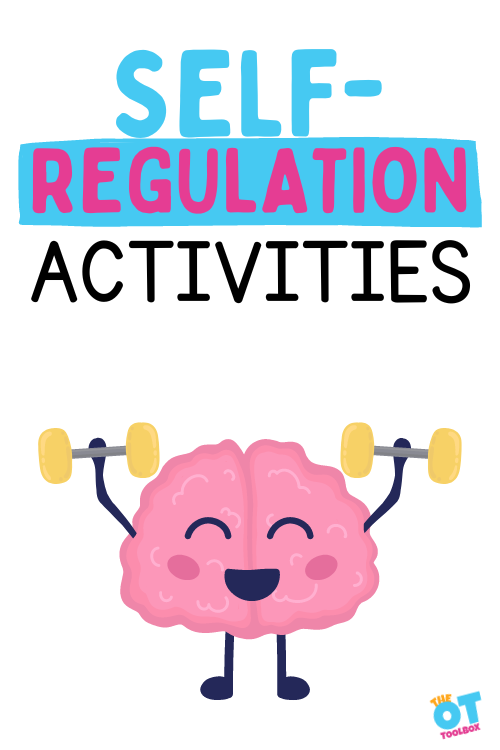
Colleen Beck, OTR/L is a pediatric occupational therapist and the owner and author of The OT Toolbox website. She manages all of The OT Toolbox social media accounts and runs the popular newsletter. Colleen created The OT Toolbox in 2011 and since then has written thousands of blog posts designed to support therapy providers, educators, parents, counselors, admin, and caregivers in promoting the healthy development of kids. Check out Colleen's blog posts below:
This blog post on Zones of Regulation, self-regulation strategies, and activities to support the Zones of Regulation curriculum was originally written July 20, 2020. It was most recently updated on November 15, 2023. The Zones of Regulation® program is a self-regulation tool to help kids identify, address, and use strategies to achieve self-control and emotional regulation in a non-judgmental and safe way. Using interactive Zones of Regulation activities in the actual program can be helpful for kids who struggle with self-regulation. Here, we’re covering information on this program as well as activities to support self regulation. Today, we are covering more information on this regulation tool as an option to add to your toolbox of strategies. In this blog post, we are not sharing activities as a replacement for the actual Zones of Regulation® program, but rather, a resource to direct individuals toward the program’s website as a resource for self regulation needs.
Here, you will find self-regulation activities (emotional regulation, internal regulation, and physical regulation strategies) and tips to work on self-regulation of emotions through fun and interactive activities. These can be used in a curriculum designed to support specific needs, or you can incorporate these strategies into a regulation station, or calm down area. Other ideas are using a variety of calm down toys in these spaces. All of us can use what we learn from the self regulation activities found in the innovative program to monitor, maintain, and change our level of regulation. These are DIY self-regulation activities that you can make as part of your occupational therapy treatment and can be used over and over again! All of us can use zones of regulation activities to monitor, maintain, and change our level of regulation. Plus, the DIY Zones activities that we show below are not intended to replace the program’s curriculum, but they can support individual needs based on the child. We offer these ideas not as interventions, but as tools you can make as part of your occupational therapy treatment to supplement the Zones of Regulation® program and can be used over and over again! This blog post is an independent resource and is not affiliated with, nor has it been authorized, sponsored, or otherwise approved by Think Social Publishing, Inc. or by Leah Kuypers, author of The Zones of Regulation.

Well, let’s break it down. “Self” means you or me. “Regulation” means the process of being in control or to have management. So, add these two terms together and you get “self-regulation”. Self-regulation means you or me being in control and having management of ourselves. Self-regulation is a skill that many children have a difficult time learning and achieving without help. In a given day, a child (and an adult) encounters multiple situations and circumstances that require an awareness of self and others as well as the ability to have or gain self-control. Self-regulation is the ability to attain, maintain, and change one’s arousal level, emotions, and behaviors. This ability to self-control relies on impulse control, working memory, and generally speaking, the ability to keep oneself “in check”. For example, using a regular emotions check in activity or a feelings check in activities can help with this ability. The ability to experience feelings and desires and make decisions based on those concepts requires motivation, willpower, higher level thinking. Generally speaking, a child should achieve an optimal level of self-awareness and mindfulness to identify their inner feelings and emotions and be ready to regulate themselves when the time comes. They need to learn strategies and techniques that work for them to assist them in leaving a less optimal level in order to get back to a “ready-to-go” level of regulation. Here are more mindfulness activities that kids can use in addition to their “Regulation Toolbox”. Using interactive zones of regulation activities can be helpful for kids who struggle with self-regulation.
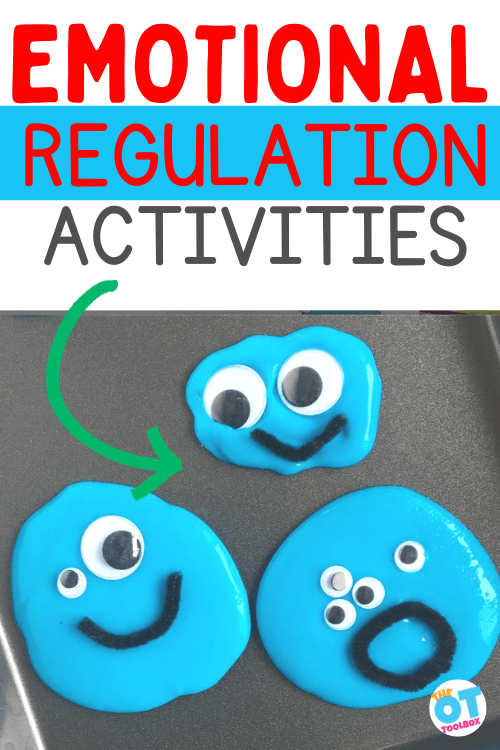
Activities to support emotional regulation and coping skills can come in many forms. In this resource, you will find specific activities to add to a zones of regulation toolbox, so that monitoring and maintaining a functional level of regulation is possible in any situation. There are zones of regulation posters, worksheets, self-regulation checks, zones of regulation games, and even cootie catchers. All of these regulation tools are strategies to help kids become more aware of their self in order to function. Let’s break it down further…
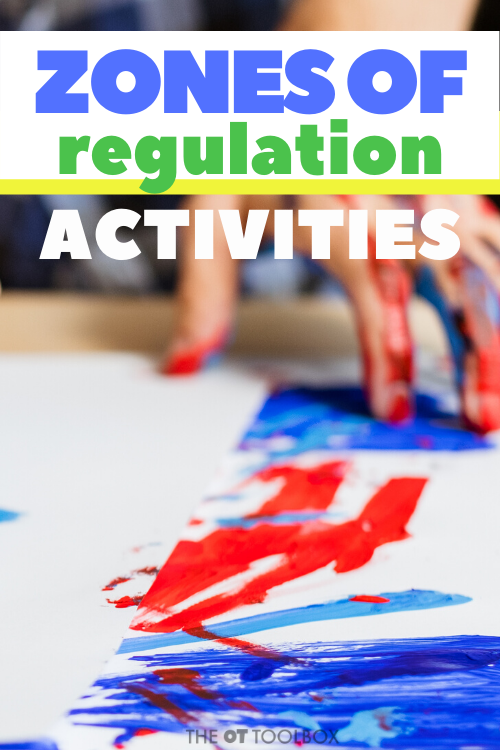
Well, let’s break it down. “Self” means you or me. “Regulation” means the process of being in control or to have management. So, add these two terms together and you get “self-regulation”. Self-regulation means you or me being in control and having management of ourselves. Self-regulation is a skill that many children have a difficult time learning and achieving without help. In a given day, a child (and an adult) encounters multiple situations and circumstances that require an awareness of self and others as well as the ability to have or gain self-control.
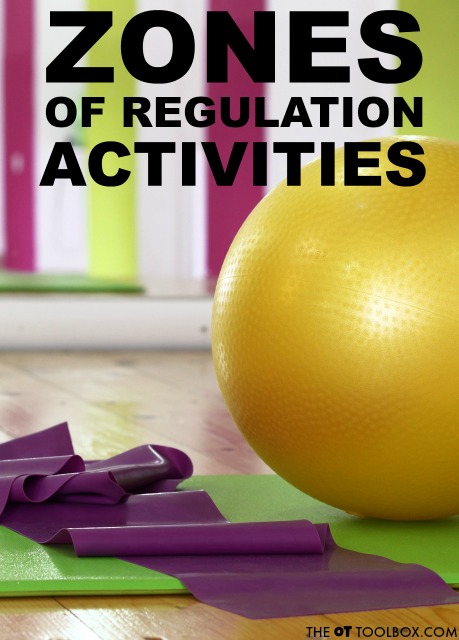
Self-regulation is the ability to attain, maintain, and change one’s arousal level, emotions, and behaviors. This ability to self-control relies on impulse control, working memory, and generally speaking, the ability to keep oneself “in check”. The ability to experience feelings and desires and make decisions based on those concepts requires motivation, willpower, higher level thinking. In order to complete tasks like learning, playing, interacting with peers, completing daily self care, etc. a child should achieve an optimal level of self-awareness and mindfulness to identify their inner feelings and emotions and be ready to regulate themselves when the time comes. They need to learn strategies and techniques that work for them to assist them in leaving a less optimal level in order to get back to a “ready-to-go” level of regulation.
Generally speaking, there are many activities to support emotional regulation. These coping skills can come in many forms. In this resource, you will find specific activities to add to a self-regulation toolbox, so that monitoring and maintaining a functional level of regulation is possible in any situation. There are emotional regulation posters, worksheets, self-regulation checks, regulation games, and even cootie catchers. Other emotional regulation therapy strategies can include using the traffic light emotional regulation concept where the red light, yellow light, and green light of a traffic light are considered for emotions and behavioral responses. All of these regulation tools are strategies to help kids become more aware of their self in order to function. Let’s break it down further and look at how and why this program works, but also where to go next when it comes to regulation strategies.
In another great resource, we covered the connection between executive functioning skills and emotional regulation.
A self-regulation program like the ones listed above are a helpful strategy for supporting self-control skills and self-regulation that impact behavioral responses. These strategies can be helpful for our children (and us adults!) to use during everyday tasks in our daily lives, whether that be schools, work, community, and homes.
Coregulation is part of this, too!
These self regulation tactics help kiddos to identify, address and use strategies to achieve good self-control and emotional regulation in a non-judgmental and safe way. Using the zones helps to take the focus off of the child as being “good” or “bad” and places the focus on obtaining control to get back to the “green zone.”
A self-regulation blueprint can be created that includes helpful strategies and self regulation activities that can be used when needed to support children.
These strategies actually teaches the child and their parents or teachers how to recognize the relationship between emotions, feelings, and their internal “state of being” with the behaviors and actions that we see.
This self awareness relationship impacts attention, learning, and emotions.
When students understand the connection between their arousal states and their ability to self-regulate, they can identify different zones or levels which they are currently in at any given time.
This is the ability to have self awareness, body awareness, and make choices that impact self regulation.
They can then use regulation tools or strategies to impact their arousal so they can appropriately and efficiently respond to the demands of a given task.
These different levels of regulation help a child recognize, categorize, and communicate their feelings or emotions based on a specific knowledge of how one’s body and mind respond to situations. This is self awareness and self regulation in action!
One of the most important steps to self-regulation is having the self-awareness that something is “off” and we need to do something physically emotionally, or cognitively and that a change must happen. This is where understanding the nervous system is important for the adult in the situation. Understanding what is happening behind the limbic system, the vestibular system, proprioceptive system, and overall sensory processing systems are key.
This makes a self-regulation strategy an effective and fluid tool for a child to understand, learn, and achieve without feeling judged or different.
One tool to support these skills is by using self awareness games. Games can help to support the individual in using self-reflection skills as a tool for beginning the internal processes needed for functional use of self-regulating strategies “in the moment”.
Let’s quickly review the various aspects of self-regulation and different feelings or emotional experiences that occur along a spectrum so you can have a better understanding of the reason behind my fun tool creations.
I designed the regulation tools shown below for individual children to help them better understand and navigate their emotions while identifying strategies that help them shift from a less desirable zone to a more calm and focused space, which is better for participating and learning at school, home, community, church, therapy, or any environmental location where the individual participates.
We have a few blog posts here on the website that explain self-regulation in greater detail.
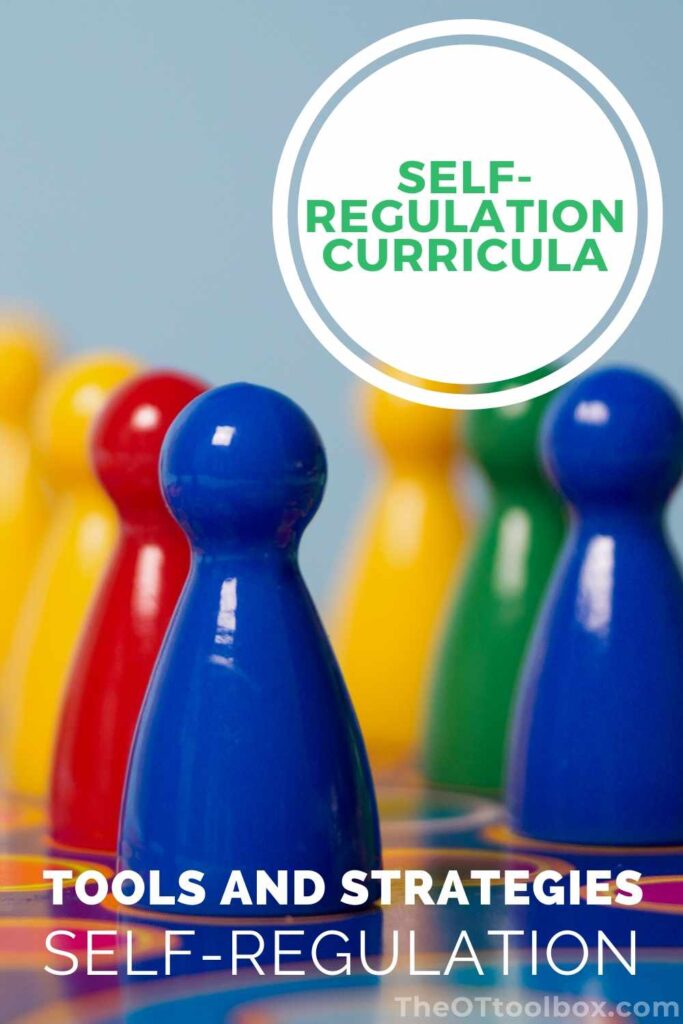
There are many different programs that offer self-regulation curriculum. These are regulation programs and interventions that can assist a child (and adult) to learn the skills necessary to achieve emotional regulation fit for every situation, circumstance, and environment.
Amazon affiliate links are included below.
Many programs, curriculum or interventions are created by occupational therapy professionals. These include:
This article on using the Mightier program for self-regulation shows how to use the application and game to help a child identify their feelings and utilize coping strategies that impact those various emotional regulation changes. The games adjust to challenge the child as they become more proficient in coping strategies.
One of the common self-regulation programs is the Zones of Regulation.
The Zones of Regulation® is a self-regulation program created by occupational therapist, Leah Kuypers, who founded the framework program in 2011.
The program supports children and families in better understanding how self-regulation works through concreate concepts, colors, and strategies.
Zones of Regulation framework created by Leah Kuypers, but rather are sharing this resource as a way for families and therapists to get started with specific activities and a plan to support regulation needs.
One of the common self-regulation programs is the Zones of Regulation.
Well, in brief summation, the Zones of Regulation program is a curriculum or framework created by an occupational therapist, Leah Kuypers, which is designed to help a child navigate their sometimes confusing emotions. The curriculum helps a child to achieve self-regulation and emotional control by gaining skills in self-control and problem-solving based on targeted zones that are identified with colors.
The Zones of Regulation program is what most of our children use in their schools and homes. This program helps kiddos to identify, address and use strategies to achieve good self-control and emotional regulation in a non-judgmental and safe way. Using the zones helps to take the focus off of the child as being “good” or “bad” and places the focus on obtaining control to get back to the “green zone.”
The self-regulation program teachers children and their parents or teachers how to recognize the relationship between emotions, feelings, and their internal “state of being” with the behaviors and actions that we see.
This relationship impacts attention, learning, and emotions. When students understand the connection between their arousal states and their ability to self-regulate, they can identify different zones or levels which they are currently in at any given time.
They can then use regulation tools or strategies to impact their arousal so they can appropriately and efficiently respond to the demands of a given task.
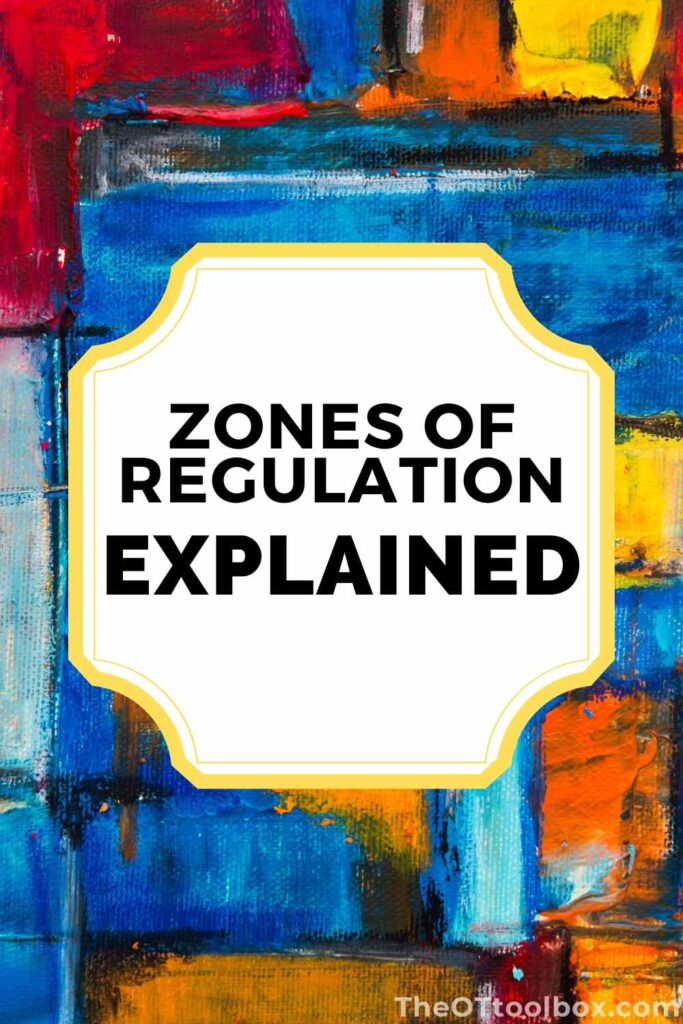
In a brief summation, the Zones of Regulation program is a curriculum or framework created by an occupational therapist, Leah Kuypers, which is designed to help a child navigate their sometimes confusing emotions. The curriculum helps a child to achieve self-regulation and emotional control by gaining skills in self-control and problem-solving based on targeted zones that are identified with colors.
These zones help a child recognize, categorize, and communicate their feelings or emotions based on a specific zone. This makes the program an effective and fluid tool for a child to understand, learn, and achieve without feeling judged or different.
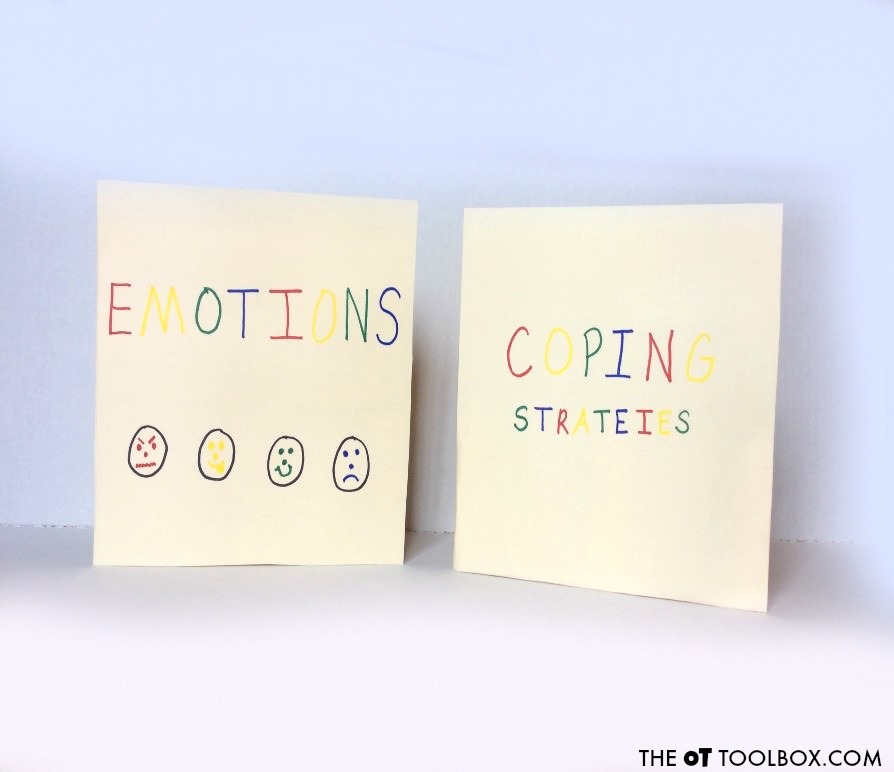
Let’s quickly review the zones so you can have a better understanding of the reason behind my fun tool creations (see below). I designed these tools for individual children to help them better understand and navigate their emotions while identifying strategies that help them shift from a less desirable zone to a more calm and focused zone, which is better for participating and learning at school, home, church, and in therapy.
In the Zones of Regulation program, there are different colors to break up different types of emotions into categories. The colors don’t mean good or bad emotions or emotional/behavioral responses, they are simply a categorizing tool.
The colors in the Zones of Regulation are:
What is helpful is that these colors can be associated with different emotion names and tools to be used to support those emotions.
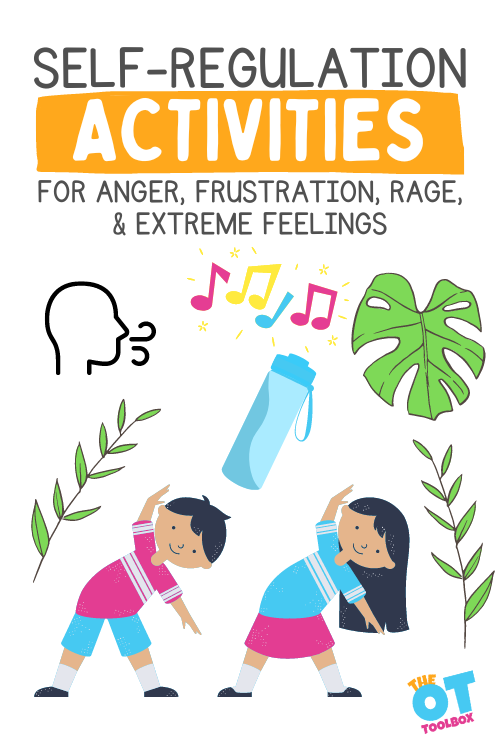
Activities to support self regulation for extreme feelings can be calming and regulating activities.
The Red Zone is an extremely heightened state of alertness with intense emotions and is typically viewed as the child being “out-of-control.”
Red Zone feelings might include:
Regulation Activities to support anger, physical reactions, extreme feelings, and “out of control” feelings may include:
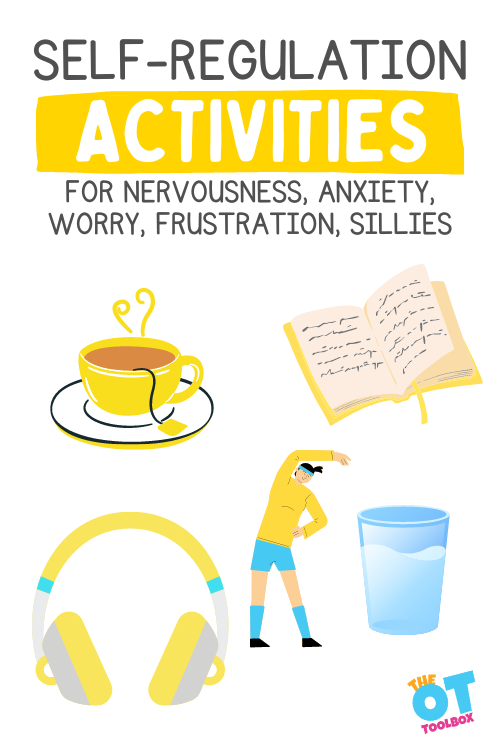
The Yellow Zone is entering a heightened state of alertness and elevated emotions typically viewed as heading toward the red zone, but the child still has some control.
Examples of Yellow Zone behaviors include:
Regulation Activities to support worried or anxious feelings, frustration, silliness, nerves, or the wiggles may include:
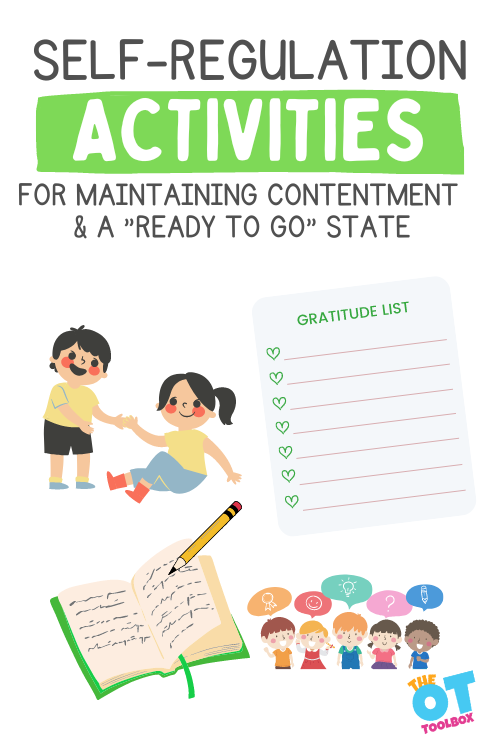
The Green Zone is the optimal level of alertness and is typically viewed as the child being “good to go” and ready for leaning and social interactions.
Examples of the Green Zone behaviors include:
Regulation Activities to support calm or focused feelings, feelings of contentment, happiness, positivity, and being ready to learn or join friends may include:
Note that when in the “green” zone according the the Zones of Regulation framework, that it’s not the end goal. This is a level of feelings that all may experience at one time or another, but it’s not necessarily considered “good” vs. “bad” when experiencing other feelings.
Strategies listed above for these feelings can be ways to journal about how one is feeling, talk to another person, expressing gratitude, or reaching out to others.
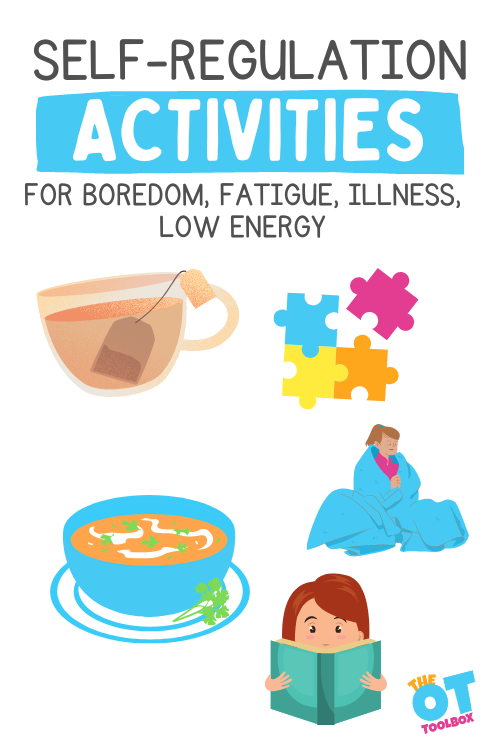
The Blue Zone is a low level of alertness typically viewed as the child running slow.
Examples of Blue Zone responses include:
Regulation Activities to support those who feel sad, tired, bored, or sick may include:
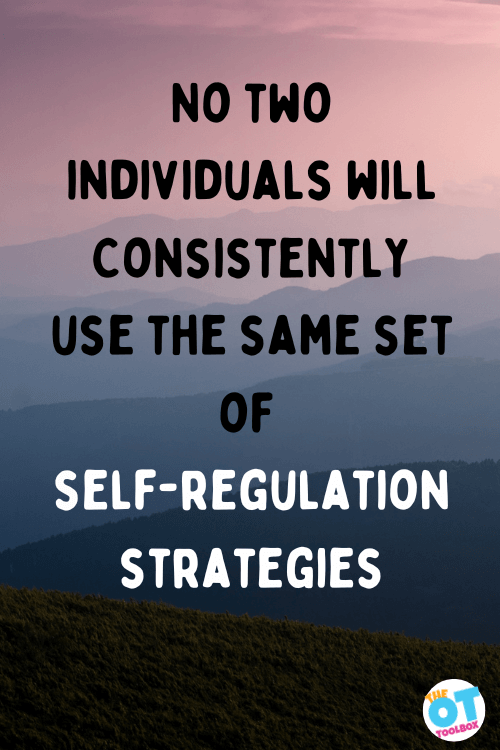
Just like there are no two children alike, and no two teens or adults alike, there is no exact blueprint to these self-regulation strategies.
Each individual will likely use different sets of mechanisms to support regulation needs.
What works for one individual may not work for another.
It’s also important to remember that emotional, cognitive, or physical regulation signs of sensory dysregulation or functional regulation can be different and change over time. Likewise, the coping skills that support regulation develop over time.
One of the key pieces to the a self regulation tool is the point that there is no one “right” level to be in. It’s OK to have emotions of all levels and behaviors that match…to a point (getting so angry that one breaks things or is destructive to property is not ok. Being so upset and frustrated that one is mean and hurtful to a friend is not ok).
We all have fluctuations of moods and behaviors. The part that is important for us as advocates for children is to offer strategies to help kids understand and identify their feelings and emotions. It’s important for kids to understand how their reactions impact others, particularly when they are not able to manage their emotional or behavioral response.
Remember the concept that there is no “right” level or regulation and there is no “wrong” level. We all have emotions that fluctuate and change and we all have physical responses, behavioral responses to these emotional levels. These responses are not right or wrong either!
Rather, it is appropriate and OK to have strategies to move from non-functional levels to functional levels, and in ways that work for the individual. If you or I are constantly in a depressed, down, or upset mood, that can have an impact on wellbeing. It can make us spiral into a deeper depression or anxiety that impacts social participation, health, functional participation. This is where it’s appropriate to have an “out” or a way to support the regulation needs.
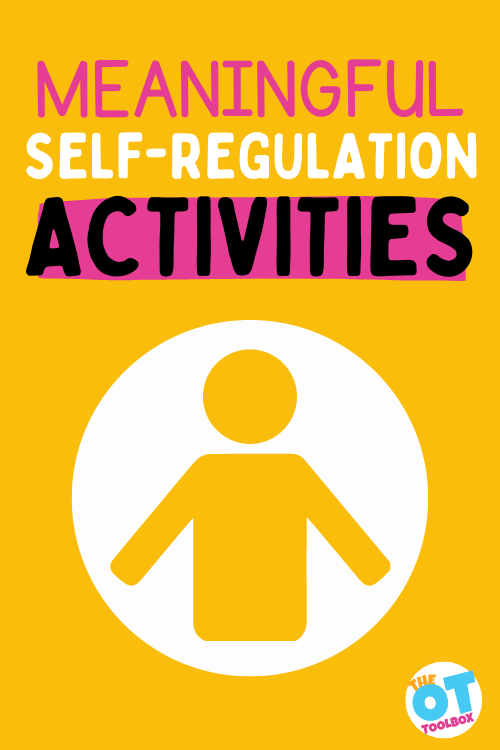
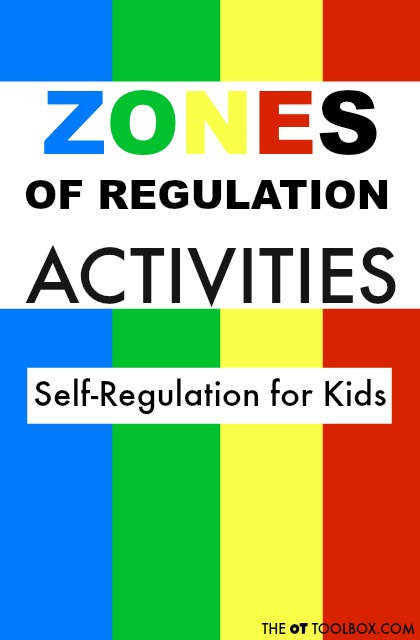
What is the best part about the fun tools I created? YOU can create them and use them with most any regulation program based on the programs framework.
Look at the fun tools I created and take the general structure and design to build essential tools to go with whatever program you may be utilizing in therapy, the classroom, or at home.
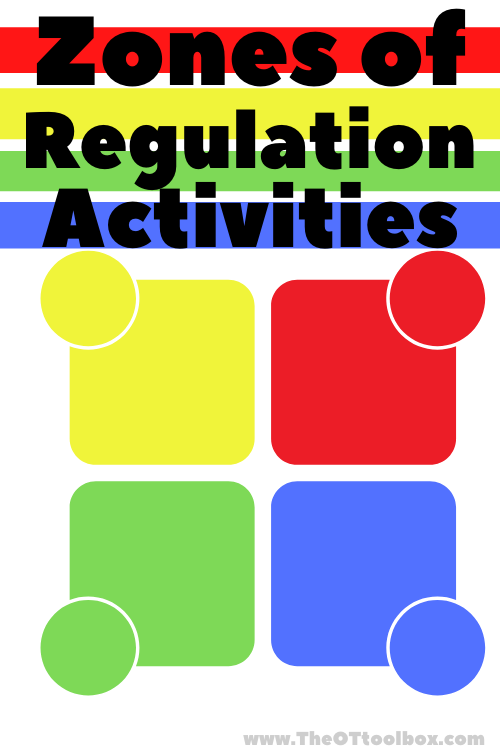
In this zones activity, kids can make the tools they need to work on self-regulation. Have kiddos fold file folders to create a pocket on the bottom.
Trim off the edges. Use hot glue to turn the large pocket into four sections (red, yellow, green, and blue). Color and label the sections based on zones. Have kiddos label craft sticks with either emotions or coping strategies and insert into the correct pockets.
This Regulation Pocket Play for Emotions and Coping Strategies Folders can be used in the home or classroom.
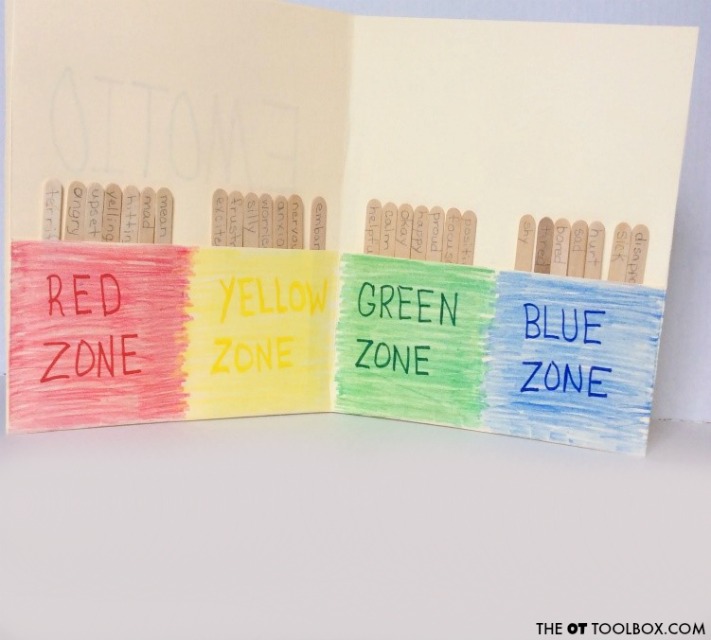
Have kiddos paint or wrap colored tape around paper towel tubes according to the zone colors. If painting, wait to dry.
Follow up with kiddos writing emotion words or even drawing emotion facial expressions onto the matching tube color. Place a hair band onto the tube to roll up and down as needed to perform check-ins with children throughout the day.
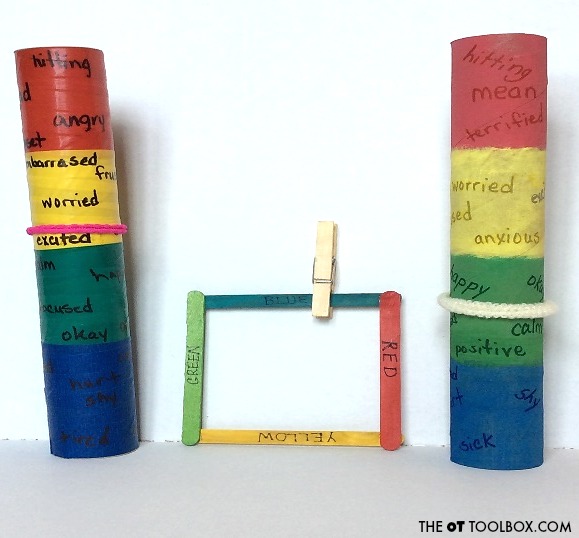
Hot glue colored craft sticks according to zone colors (red, yellow, green and blue) to create a square frame and then have child write the zone title on one side and zone emotion words on the other side OR have child write zone emotion words on one side and coping strategies on the other side.
Place a clothespin onto the frame to clip as needed to perform check-ins with children throughout the day. This tool can also be used to teach and review while learning the program zones as well.
Have kiddos create an emotion identification grab bag game. This can be done in differentiated ways:
Once these are created, toss only the caps or only the spoons into a grab bag or simply toss them all into one bag.
When children grab a cap or spoon from the bag, they decide which colored mat they belong on to identify the correct emotion and zone.
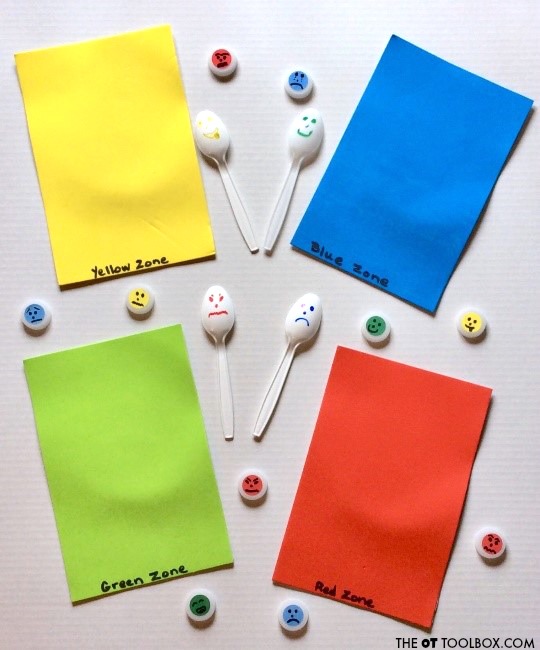
Use this Lion and lamb self- regulation craft to identify emotions and talk about “lamb” emotions and responses and “lion” emotions and responses.
Identifying coping strategies that work for each individual can make all the difference in having a set of “go to” regulation strategies when the need presents itself.
This massive list of coping strategies for kids are perfect for filling a coping skills toolbox. Write them out on slips of paper, add them to a flip book, make them into coping skills Popsicle sticks, or add them to a coping strategies bulletin board.
Kids can go through the various calming and alerting activities and use them to self-regulate.
Use a file folder or slide a paper into a page protector to create a Zones of Regulation chart using movement activities in the classroom. Kids can mark off their zone and pick from a coping mechanism to help them get to a zone in which they can learn and pay attention.
This is a helpful strategy for self control and self regulation.
Using a printed journal like our Self-Reflection Journal or the Impulse Control Journal can help kids identify more about themselves, become more self-aware, while reflecting on their day and week.
They can write down their actions, emotions, and responses and then look back at what worked and what didn’t work. By using a written journal, children can describe good and poor choices that they’ve made and then write out tools that they can try next time.
Journaling is a conversation tool to use when talking about what works and what doesn’t work for a child with a variety of needs.
The Impulse Control Journal takes self-reflection a step further by working on the impulses that impact behavioral regulation or emotional regulation and the actions that we see. This tool is effective in helping kids and teens to identify emotions, reactions, responses, and learning strategies to change their regulation through self-awareness.
Kids can choose strategies independently and see progress by working through the Impulse Control Journal pages.
The first step of self-regulation is the ability to identify emotions. Social emotional learning begins with naming emotions, matching emotion names to faces and body language.
When kids identify emotions, they can begin to develop empathy for others but also become more self-aware of their own emotions, the things that impact those feelings, and how they respond. Some ways to identify emotions through play include:
When kids explore self regulation skills by experimenting with sensory input, kids can identify the terms that their body feels when they are exposed to that sensory input.
If done during a calm time, when the child is at high alert and concentration, they are able to fully experience the input without distraction. Kids can then create a zones toolbox using the self-regulation skills that work for them.
Try these self regulation skills exploration with kids:
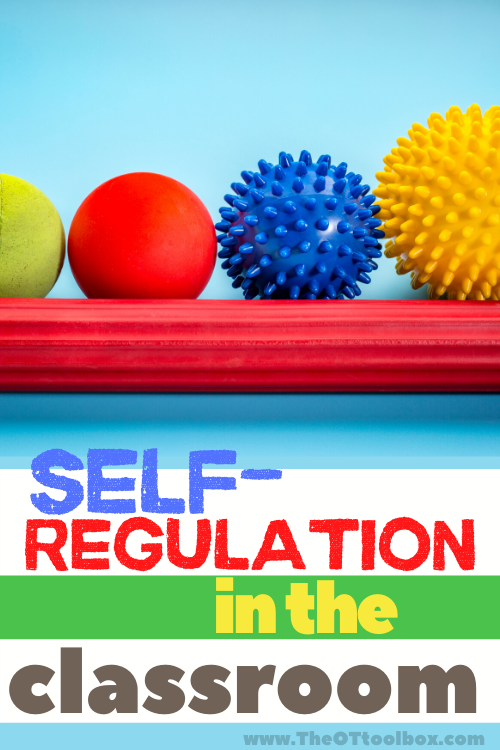
Self regulation in the classroom can impact learning, attention, focus, and student interaction.
Now that you know some zones of regulation activities, you can use them in the classroom or learning environment. Whether that be in the traditional school setting, in homeschooling, or in remote learning settings, the a regulation curriculum or practical self regulation strategies are effective to foster learning.
Go ahead and make these fun and easy Zones of Regulation tools to help your kiddos learn emotional regulation and self-control to help them succeed in their daily lives so they can feel good and remain cool. Kiddos will enjoy the interactive components and you’ll see learning and regulation evolve! They can be used at home or in the school environment.
While anger is a very good and normal emotion, when anger becomes too much for communication, functional tasks, and leads to meltdowns and tantrums that impact safety of oneself and others, talking about anger and this extreme feeling can be very beneficial.
One strategy is an Anger Poster, or an Anger Zone Poster.
An Anger Poster might include a space to draw or write about things that lead to uncontrollable anger. There can be pictures cut out of magazines or printed from online that show what leads to these intense feelings.
It’s important to include things on the poster like a social story of sorts that shows how not to act or behave, including dangerous consequences or hurting others as a result of angry feelings.
You can also include coping tools to support these intense feelings.
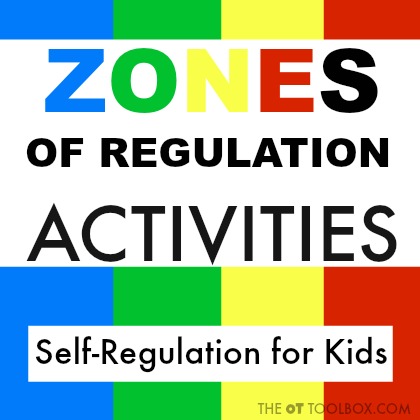
What is the best part about the fun tools I created? YOU can create them and use them with most any regulation program based on the programs framework.
All of the specific self-regulation activities that are listed above can be interchanged, and used as able to help move from one zone to another. Each child will be different emotional levels that they need to move from or into so that functional participation can occur.
In this self-regulation craft and activity, we used a lion and a lamb concept to bring the abstract meaning of regulation to a concrete place of learning and exploration, by helping kids to see that self regulation strategies can make a huge difference in paying attention and learning in the classroom or completing tasks that need to be done at home.
As support for those struggling with self-regulation challenges, modeling is the strongest tool that we have as adults/parents/therapists to teach kids/teens/others how to cope.
Other self-regulation strategies can be anything that helps the individual feel centered, focused, and able to participate in everyday tasks. Some of these strategies can include:
One of the key pieces to the Zones of Regulation is the point that there is no one “right” zone to be in. It’s OK to be in the red zone or the yellow zone. We all have fluctuations of moods and behaviors. The part that is important for us as advocates for children is to offer strategies to help kids understand and identify their feelings and emotions. It’s important for kids to understand how their reactions impact others, particularly when they are not able to manage their emotional or behavioral response.
All of the Zones of Regulation activities that are listed above can be interchanged, and used as able to help move from one zone to another. Each child will be different in the zones strategies that works for them.
The resources in the Sensory Lifestyle Handbook really go into detail on this concept, in using movement and sensory tools as regulation strategies and coping tools to help kids function, within their daily functional tasks. For example, it is possible to incorporate regulating activities within the classroom, home tasks like self-care or chores, and the community. Check out the Sensory Lifestyle Handbook for more information on this concept.
There are so many options for zones of regulation activities for kids. What would you add to this list?
This post was written in part, by The OT Toolbox contributor, Regina Allen. Read about Regina in her Contributor Author Spotlight.

Colleen Beck, OTR/L has been an occupational therapist since 2000, working in school-based, hand therapy, outpatient peds, EI, and SNF. Colleen created The OT Toolbox to inspire therapists, teachers, and parents with easy and fun tools to help children thrive. Read her story about going from an OT making $3/hour (after paying for kids’ childcare) to a full-time OT resource creator for millions of readers. Want to collaborate? Send an email to contact@theottoolbox.com.